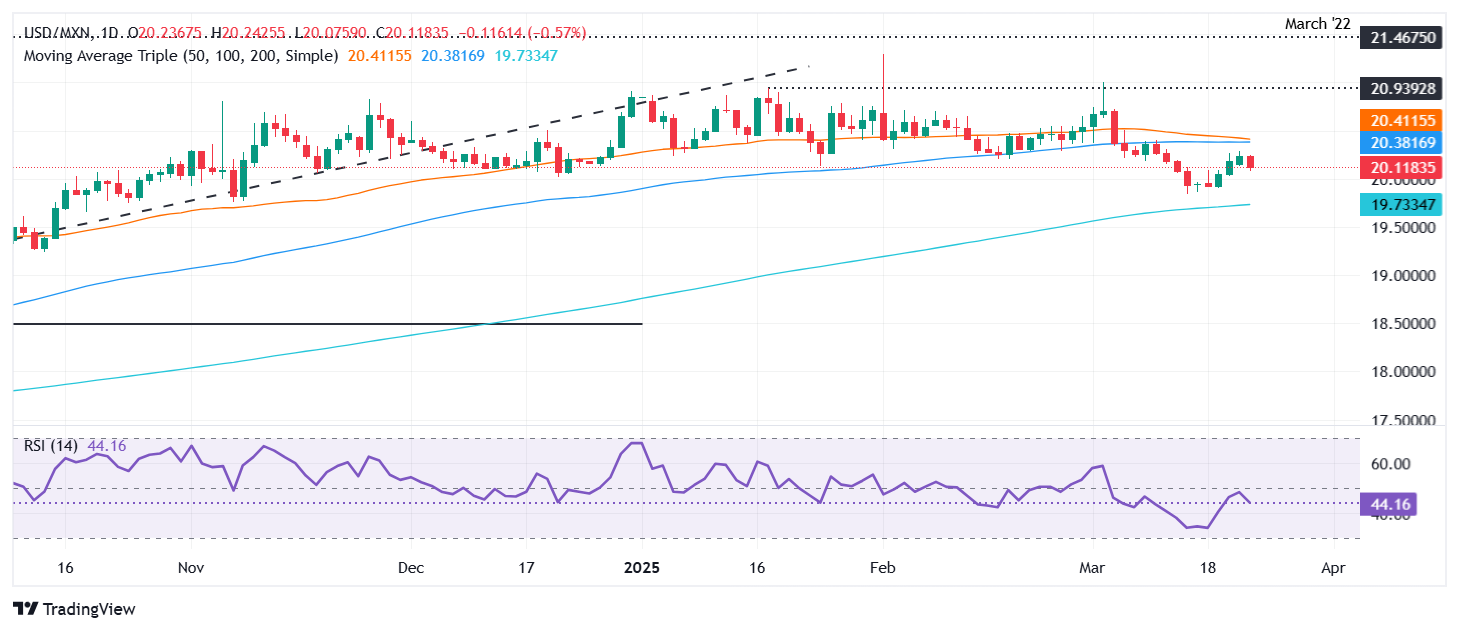Mexican Peso rallies as tariff fears ease, eyes on Banxico’s decision
- Mexican Peso strengthens by over 0.6% as US tariff measures seen as targeted and not broad-based.
- Mexico’s inflation cools and the economy shrinks, reinforcing speculation of a 50 bps Banxico rate cut.
- Focus shifts to Banxico decision, Mexico trade data and US Core PCE inflation print.
The Mexican Peso (MXN) stages a recovery against the US Dollar (USD), appreciating over 0.64% amid relief of reciprocal tariffs imposed by the United States (US). Mexico’s docket hints the economy contracted while the disinflation process continued to evolve, revealed data from the Instituto Nacional de Estadistica Geografia e Informatica (INEGI). At the time of writing, USD/MXN trades at 20.09.
Over the weekend, Bloomberg revealed that April’s 2 reciprocal tariffs would target specific countries rather than applying duties broadly to all imports. Investors, relieved by the news, drove US equities higher.
In Mexico, the Consumer Price Index (CPI) for March’s first half dipped compared to estimates on a monthly and annual basis. Excluding food and energy, the so-called core CPI stood within Banco de Mexico’s (Banxico) target of 3% plus or minus 1% on inflation.
Other data revealed that the Mexican economy shrank in January, revealed the INEGI. Given the evolution of the disinflation process and a weakening economy, Banxico is expected to reduce rates on Thursday, with most analysts eyeing a 50 basis point (bps) rate cut.
Across the border, S&P Global revealed Flash PMIs for the US, with the data faring mixed, with manufacturing activity contracting, opposite to services, which improved compared to February’s figures.
This week, Mexico’s economic docket will feature Trade Balance numbers and Banxico’s interest rate decision. In the US, traders would eye the Fed’s preferred inflation gauge, the core Personal Consumption Expenditures (PCE) Price Index.
Daily digest market movers: Mexican Peso climbs as data fuels Banxico cut
- The Citi Mexico Expectations Survey showed that most analysts expect interest rates to end at 8% in 2025, down from 8.25% in the previous release. USD/MXN is expected to end at 20.98, down from 21.00 in the last survey.
- Inflation expectations remained anchored in the high 3% range, while GDP is foreseen to expand by 0.6%, down from 0.8% in the last survey.
- INEGI revealed that March’s mid-month inflation rose by 0.14% MoM, down from February’s estimates of 0.15% and 0.22%. On an annual basis, YoY rose 3.67%, down from 3.74% and beneath forecasts of 3.75%.
- Core inflation for the same period stood at 0.24% MoM, as expected, down from 0.27%. In the twelve months to March, it increased by 3.56%, down from 3.63% and below projections of 3.57%.
- Mexico’s IGAI Economic Activity for January fell 0.1% YoY in January, up from December’s 0.4% contraction. The index decreased by 0.2% monthly, though it improved from a 1.0% plunge.
- S&P Global revealed that manufacturing activity in the US deteriorated sharply, as depicted by the S&P Global Manufacturing PMI in March, which dipped from 52.7 to 49.8, below estimates for a 51.7 expansion.
- Contrarily, the S&P Services PMI expanded from 51.0 to 54.3 for the same period, crushing estimates for a 50.8 deceleration.
- Traders had priced the Fed to ease policy by 64.5 basis points (bps) throughout the year, as revealed by data from the Chicago Board of Trade.
USD/MXN technical outlook: Mexican Peso surges as USD/MXN tumbles below 20.15

USD/MXN remains trendless, but so far, at the time of writing, enjoys a dip as traders wait for Banxico’s decision. Although a rate cut would be bullish for the Greenback, sellers remain in charge, eyeing a test of the 200-day Simple Moving Average (SMA) at 19.69.
To reach that level, they first need to clear the 20.00 psychological figure. On the other hand, if buyers push USD/MXN past the confluence of the 100 and 50-day SMAs near 20.35/39, the next resistance would be the 20.50 mark. Once surpassed, a move towards 20.99 is on the cards.
Mexican Peso FAQs
The Mexican Peso (MXN) is the most traded currency among its Latin American peers. Its value is broadly determined by the performance of the Mexican economy, the country’s central bank’s policy, the amount of foreign investment in the country and even the levels of remittances sent by Mexicans who live abroad, particularly in the United States. Geopolitical trends can also move MXN: for example, the process of nearshoring – or the decision by some firms to relocate manufacturing capacity and supply chains closer to their home countries – is also seen as a catalyst for the Mexican currency as the country is considered a key manufacturing hub in the American continent. Another catalyst for MXN is Oil prices as Mexico is a key exporter of the commodity.
The main objective of Mexico’s central bank, also known as Banxico, is to maintain inflation at low and stable levels (at or close to its target of 3%, the midpoint in a tolerance band of between 2% and 4%). To this end, the bank sets an appropriate level of interest rates. When inflation is too high, Banxico will attempt to tame it by raising interest rates, making it more expensive for households and businesses to borrow money, thus cooling demand and the overall economy. Higher interest rates are generally positive for the Mexican Peso (MXN) as they lead to higher yields, making the country a more attractive place for investors. On the contrary, lower interest rates tend to weaken MXN.
Macroeconomic data releases are key to assess the state of the economy and can have an impact on the Mexican Peso (MXN) valuation. A strong Mexican economy, based on high economic growth, low unemployment and high confidence is good for MXN. Not only does it attract more foreign investment but it may encourage the Bank of Mexico (Banxico) to increase interest rates, particularly if this strength comes together with elevated inflation. However, if economic data is weak, MXN is likely to depreciate.
As an emerging-market currency, the Mexican Peso (MXN) tends to strive during risk-on periods, or when investors perceive that broader market risks are low and thus are eager to engage with investments that carry a higher risk. Conversely, MXN tends to weaken at times of market turbulence or economic uncertainty as investors tend to sell higher-risk assets and flee to the more-stable safe havens.

